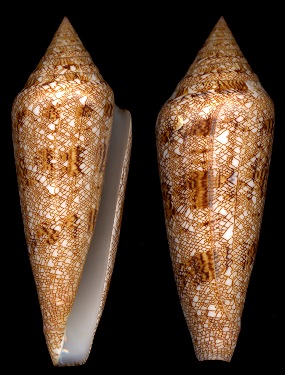| Conus gloriamaris Chemnitz, 1777 |
| The Glory-of-the-Seas Cone |
 |
| Manila Bay, Philippines, 96 mm. |
| The reputations of rare shells die hard - sometimes
almost a generation after the species has proved to be common.
The most touted of the rarities was the Glory-of-the-Seas Cone
- known from only a couple of dozen specimens for the next hundred
years after its description. False tales and high auction prices built this species into a holy grail. In 1856, it was erroneously published that the great Danish cone collector Chris Hwass had purchased one at an auction in 1792 and immediately crushed it underfoot to make the one he already possessed all the more valuable. A second false tale was published in connection with the discovery of two specimens near Bohol, Philippines, by Hugh Cuming in 1837. A few years later it was reported that an immense earthquake had swallowed up the living grounds of this now-extinct species. The tales added to the desirability and sale price of the species. By 1957, 24 specimens were known and the same year one specimen sold for $2,000. By 1964, twice that number had been discovered in New Guinea. The jackpot was found by two Australian SCUBA divers in 1969, when they collected over 120 specimens on the north shore of Guadalcanal Island, Solomons. Today, a quality specimen of this beautiful cone may be obtained for less than $100. |